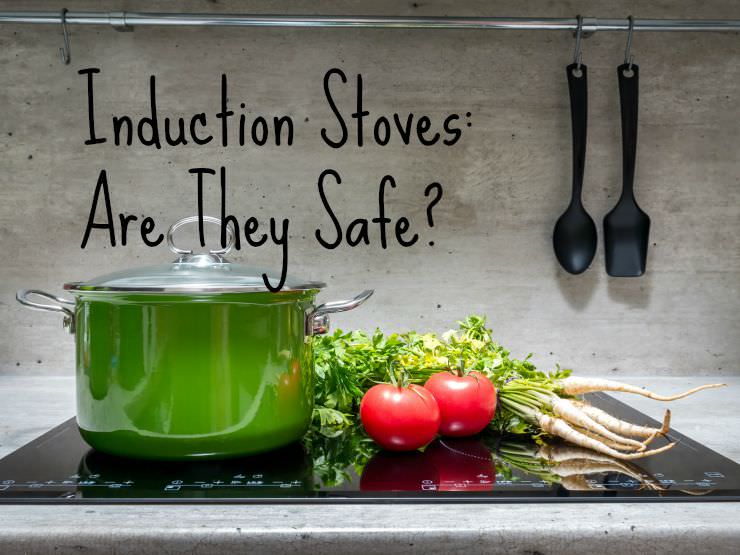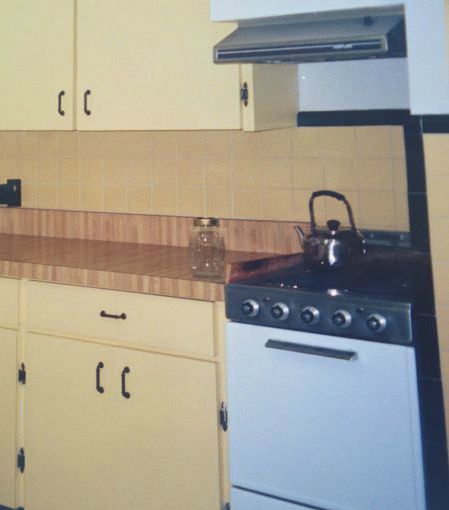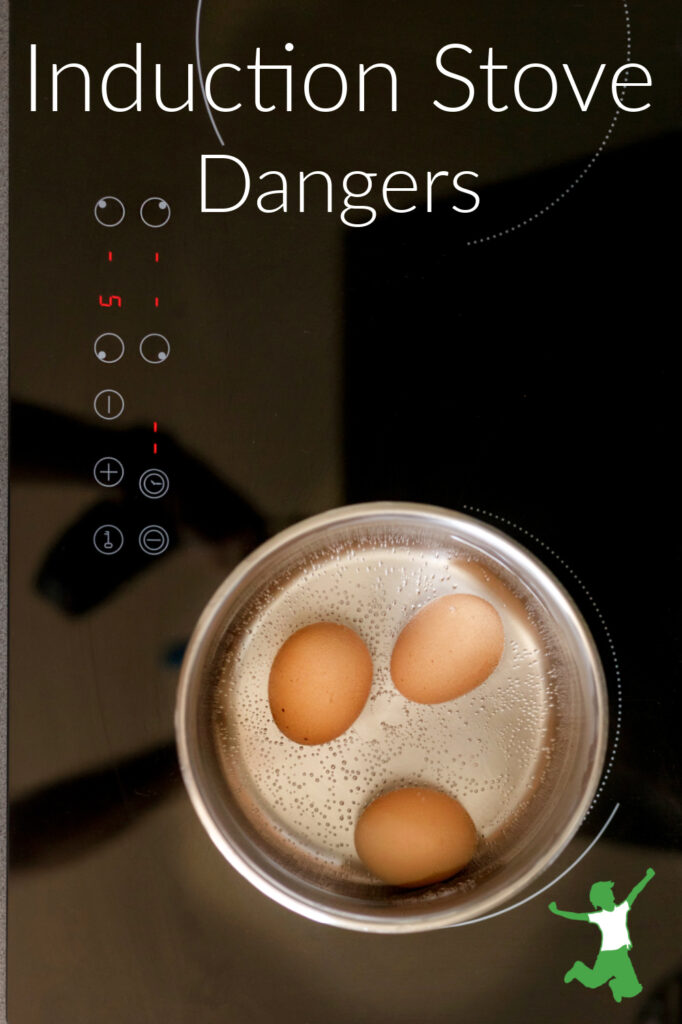The important reasons why bringing an induction stove into your home should be approached with caution as this technology is a source of excessive EMF toxicity as confirmed by scientific study. Even induction stove user manuals warn against standing too close!

Buying a kitchen stove is a rare purchase most people make only a few times in a lifetime. Currently, the trend toward replacing electric cooktops with an induction stove is quite popular. Is this a wise purchase? Let’s take a look …
In our home, we purchased a glass top stove in 1997 when we completely remodeled the (very old) kitchen. At that time, the range we selected boasted the latest and greatest technology which included a glass top cooking surface.
We were upgrading from a tiny 1950’s stove (see hilarious picture below) that while it seemed to fit very well with the orange, 1970s style wallpaper, fake butcher block countertops and canary yellow cabinets (no kidding), it was not something we regretted replacing!
While this new range was awesome (so nice not to have to clean up messes under coil burners anymore!) and has served us well for many years, it recently came time to replace it when problems developed.
Induction, Gas or Electric?
Since we had upgraded to the best technology many years earlier with good results, we thought we should probably do so again. This involved the purchase of an induction stove with all the bells and whistles. The upgrade hopefully would make my many hours spent in the kitchen even more efficient.

Since indoor air-polluting gas stoves were thankfully not an option for our neighborhood, electric was our only choice. We made the rounds to Best Buy, Home Depot, and online to see what was available.
We eventually settled on a stainless steel induction stove. It offered nearly all the latest technology of the (amazing but ridiculously expensive) Viking stoves that celebrity chefs use but with a much more reasonable price tag.
This is the induction stove we originally picked that thankfully, we never bought (we bought this one instead).
I particularly liked the extra-large knobs and oversized glass top that prevented spills from trickling down the crack between the stove and the countertop. It was exactly what I was looking for.
We also decided to get the matching convection oven (that also functions as a toaster) to replace our old microwave oven that I only ever used for storage anyway.
Little Known Dangers of an Induction Stove
Really excited about our upcoming purchase, I posted about it on social media to see if anyone had any further input.
Right away, a couple of comments got my attention.
Jeanette K. said, “My mother’s induction stove was measured by EMF professionals and had extreme readings.”
In addition, Beth H. warned that “The only downfall [with an induction stove] is that you have to use pans that magnets can stick to”.
EMF Risks?
So glad I asked for the input! Neither of these concerns about induction stoves was mentioned by the salespeople I spoke to or the marketing material I had reviewed.
Since I frequently cook with glass, having to only use pans that magnets can stick to would be a serious downside.
It would require purchase of a few pieces of new cookware and bakeware which I really didn’t want or need.
But, it was Jeanette’s comment about the EMF dangers of an induction stove that really gave me pause. EMF overexposure is a huge concern of mine that I’ve written many articles about.
We take great pains in our home to minimize excessive EMF exposure such as turning off wifi at night, using radiation canceling cases and headsets for our cellphones, and EMF shields for our PCs and notebooks.
I also avoid dirty electricity in our home by never using dimmer switches, fluorescent, or LED bulbs.
In addition, we use battery power for our electronics as much as possible. Higher EMF exposure occurs when you use a laptop while it is plugged in, for example.
Induction Technology Emits Strong Magnetic Fields
When I started examining the technology behind an induction stove, I was more than a little shocked and incredibly grateful Jeanette had commented about it to clue me in to do further research. Here’s what I found out:
The technology of an induction stove works by alternating magnetic fields that generate heat in a cooking vessel made of ferrous metals. The benefits of induction cooking as opposed to thermal heating with a traditional stovetop include up to 50% faster and more even cooking of the food and slightly reduced energy usage.
Parents of young children like it because the coil itself underneath the glass stovetop doesn’t actually get hot. This means the cooking surface stays cool and won’t burn little hands or steam up if you spill liquid on it.
While it is extremely controversial whether this type of radiation source is actually dangerous, the data is sufficient enough for me to avoid it.
The latest information I found that should give anyone pause about bringing an induction stove into their home was published by the Journal Bioelectromagnetics in 2012. (1)
The study authors concluded that most induction hobs (rings) exceeded even the high 1998 maximum exposure levels set by the International Commission on Non-Ionizing Radiation Protection (ICNIRP) when a person was standing close to the induction stove.
The worst-case scenario was an up to 16-fold increase from these maximum exposure levels!
Safety Tests
So how in the world did induction stoves ever pass the safety tests?
According to Powerwatch, the safety tests assumed that a person’s body is never closer than 1 foot (30 cm) to the front of the induction stove. Standing that far away would be considered “normal usage”.
I don’t know about you, but I don’t cook standing at least a foot away from my stove. My arms definitely aren’t long enough!
In fact, this would be pretty much impossible if you needed to reach the back burners.
Don’t Use a Microwave? You Won’t Want Induction Either
The bottom line is that if you avoid microwaved food and microwaves in general, you will want to pass on the induction stove as it uses similar technology.
I’ve not used a microwave in 25 years (and not missed it for a second, I might add). Why would I start now exposing myself and my family to potentially dangerous, concentrated sources of EMFs with an induction stove which works in a similar fashion?
Of course, induction stove manufacturers insist the technology is safe.
They claim that the radiation hazard dissipates within a few inches to a foot of the appliance. “Normal usage” would not expose a person to a radiation hazard.
Right?
I’ll pass thanks.
Safer Alternatives
Fortunately, the exact same stove I wanted was available in a traditional, thermally based cooktop without an induction feature. This is the case with all the induction ranges I examined in fact!
This is the stainless steel electric stove model we eventually bought. We’ve had it for several years now and continue to love it! As a bonus, it much more easily fit within our budget than the unsafe induction models!
Sometimes the latest and greatest isn’t always the best or even the safest.

References
(1) Exposure of the human body to professional and domestic induction cooktops compared to the basic restrictions
(2) Powerwatch: In Your Home. EMF Cooking Safety
(3) Induction stove user manual
More Information
Are Pressure Cookers Safe (and do they form MSG in food?)
Clay Pots for Safe Cooking
10 Tips for Using Stainless Steel Cookware Safely
Fitbit Health Concerns (particularly while you sleep!)
Are AMR Devices Safer than Smart Meters?
Heavy Metal Toxicity Raises Risk of EMF Sensitivity
Reducing Exposure to Dirty Electricity
The Health Hazards of Wireless Baby Monitors
Harvard MD Speaks Out about the Health Dangers of Smart Meters
Protect Yourself from a Smart Meter








Sarah, I’d like to know your opinion about how gas and electric stoves compare. We have to buy a new stove and we definitely prefer gas as it seems to cook so much better. However, the release of all the toxic chemicals in the air doesn’t seem ideal. However, I feel that the EMFs are a concern even with a regular electric stove. How does one make a decision?
I know so many people love gas and that is of course their choice. I have never felt too comfortable with it. I prefer electric. Just me.
I don’t think EMF is really that dangerous. depends on the frequency and energy content. In the case of the induction stove, the manufacturers claims that the field does not extend beyond a few inches is true.. magnetic fields follow a path that begins and ends at the source object (fixed magnet,coil,whatever). These paths follow , if you like, a ‘path of least resistance’ …. in other words the pan itself ‘shorts’ the field … that how it works.. by dissipating the energy in the metal of the pan, hence transferring it to the food. When no pan is in place, a few things happen … the resonant frequency of the drive (coil etc) changes, and directly reduces the amount of energy in the system.
It’s fine, honestly…. (and no, I’m not in the induction cooker business, nor do I own one … altthough I may or may not next time.,but EMF is not really one of the the decision makers) .
EMF means electromotive force or electromagnetic field, induction motors are used in washing machines, these create emf too, but it’s safe.
When I put a radiation app on my phone to use the fieldsensors to read emf, it gave huge values on the electric stove, even when it’s turned off. We should question how induction affects our food. The pan should absorb all radiation.
Sarah,
You may want to look into powerline internet adopters, getting internet in different rooms without wifi. Our company uses Asoka Pl9661 to route internt to your laptop without wifi. It reduces people’s headaches, and also help to concentrate, even some people experience less speedup heart rate.
How it works: youtube.com/watch?v=ugBDc7wYvXg
Like you, I think our schools, public facilities should emit less EMF pollution.
After reading this article I was a bit skeptical about buying an induction stove top, but after weighing up all the pros/cons, I did anyway, and so far from my experience, l think I made the right choice. It heats faster than traditional heating methods (including gas) and so far I haven’t experienced any I’ll effects from using it. It’s also beneficial if you live somewhere where electricity and gas is stupid expensive, so there is a market for it. Now granted there are some potential health concerns to take into account, as illustrated in this article, but so far, for my experience induction is far better alternative to traditional heating methods.
Hello, Sarah! Thank you for sharing your insights here. I just had a brand new General Electric convection range installed in my house. After a few minutes of turning the oven on at 425 degrees, I noticed a toxic chemical smell. So I typed “new oven smell toxic” into a search engine and found articles about the need for “burning in” a new oven.
Apparently there are chemicals used in the manufacturing process, and a residue of these chemicals is left behind which must be cooked off when a consumer gets a new oven. Debra Lynn Dadd has a blog post about it with many people weighing in in the comments about toxic smells that won’t go away after many cookings:
debralynndadd.com/q-a/new-general-electric-stove-is-toxic/
In any case, I am getting ready to try this “burning in” soon, and I’m wondering if you have had any experience dealing with a toxic chemical smell coming from your new oven? Thanks!
Is this induction cooker can give cancer to the user?
You understand that the coal and oil burned to feed your relatively inefficient electric stove is a far, far worse threat to your health and that of your community, right? And that a foot is literally only 12 inches? Like, if you stand a foot away from your cooking and bend down to pick up a quarter on the floor you’d smash both knees into the stove *and* your head against the counter? Put it this way…. a foot isn’t even enough space to lay down an average cookbook between you and the cooking surface.
You, good lass, are standing way too close. 🙂
Now, don’t use metal implements with it? Exactly right. Same as you should never put metal in a microwave.
A final note. I do think that humans are more susceptible to EM fields than some people believe, but I also know that we are, and have been, swimming in an electromagnetic soup for generations now, and that anyone who uses a cellphone or an old computer monitor is already in more ‘danger’ than anyone using a microwave or induction (properly that is…. can’t protect against stupid, cinnamon challenge types). Anything that can save power/time with this level of “risk” is a good thing.
I’m so glad I read this comment and article. I was this close to buying induction after going to lengths to avoid radiation, including paying extra for a non wifi electric meter I would have been mega upset to find this out later. I’m SO glad. I’m going to look for electric glass top. Plus I use Vision ware glass cookware, it works the best for me. I don’t want to go back to stainless steel. I don’t even like the idea of magnetised cooking surfaces really.
Somebody uploaded a video saying levels were massively high for 2 meters around induction stoves in all directions. Shouldn’t be so hard to survive in modern world?
Can you post a link?